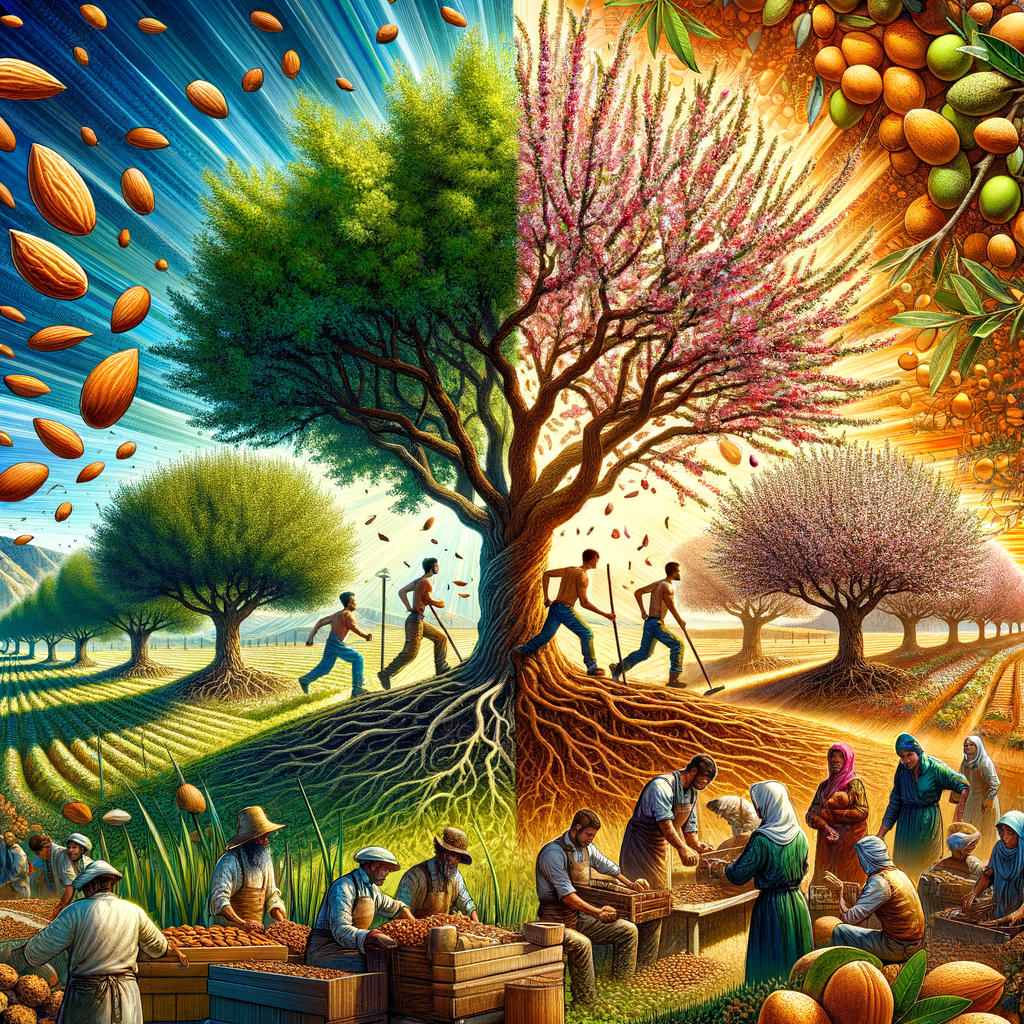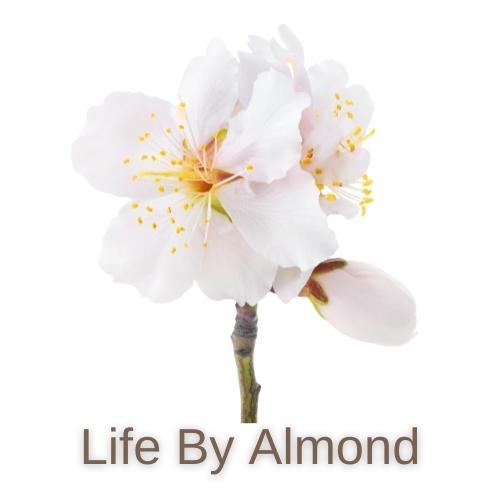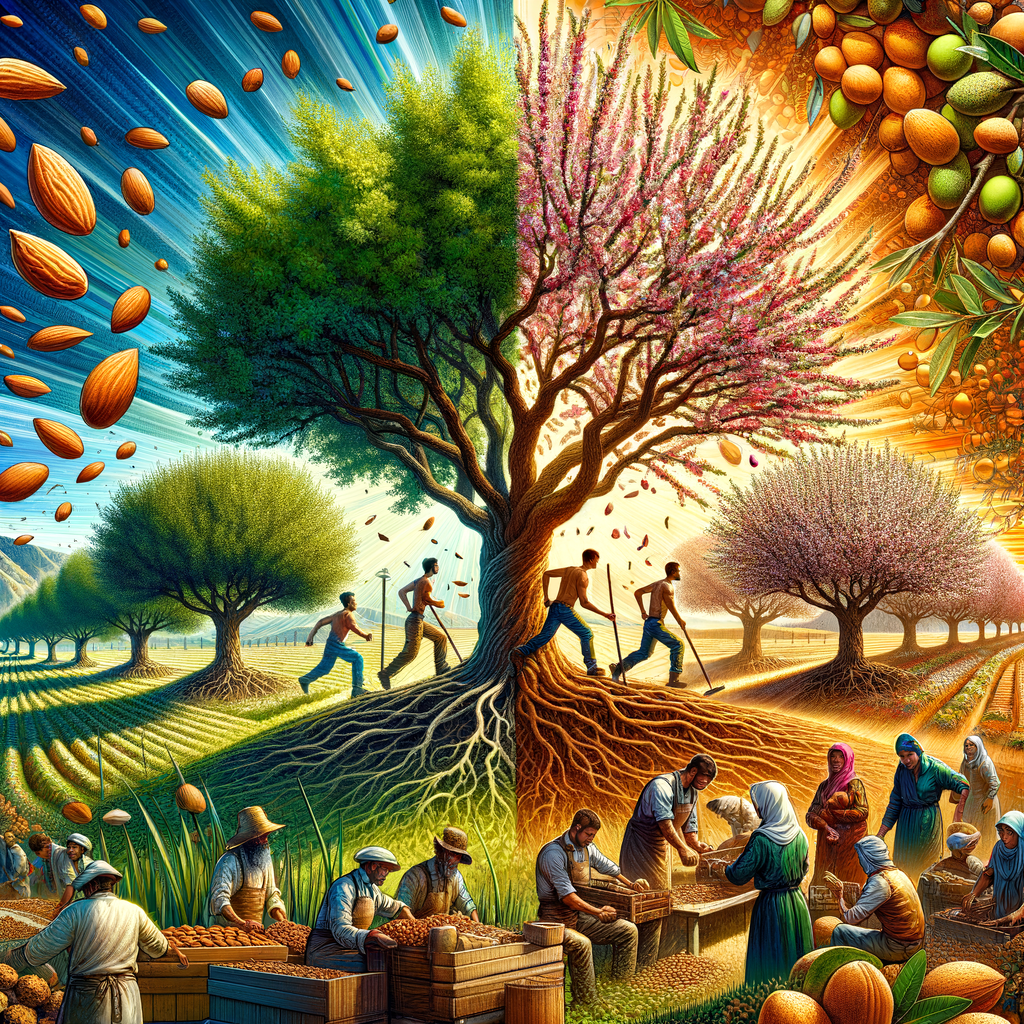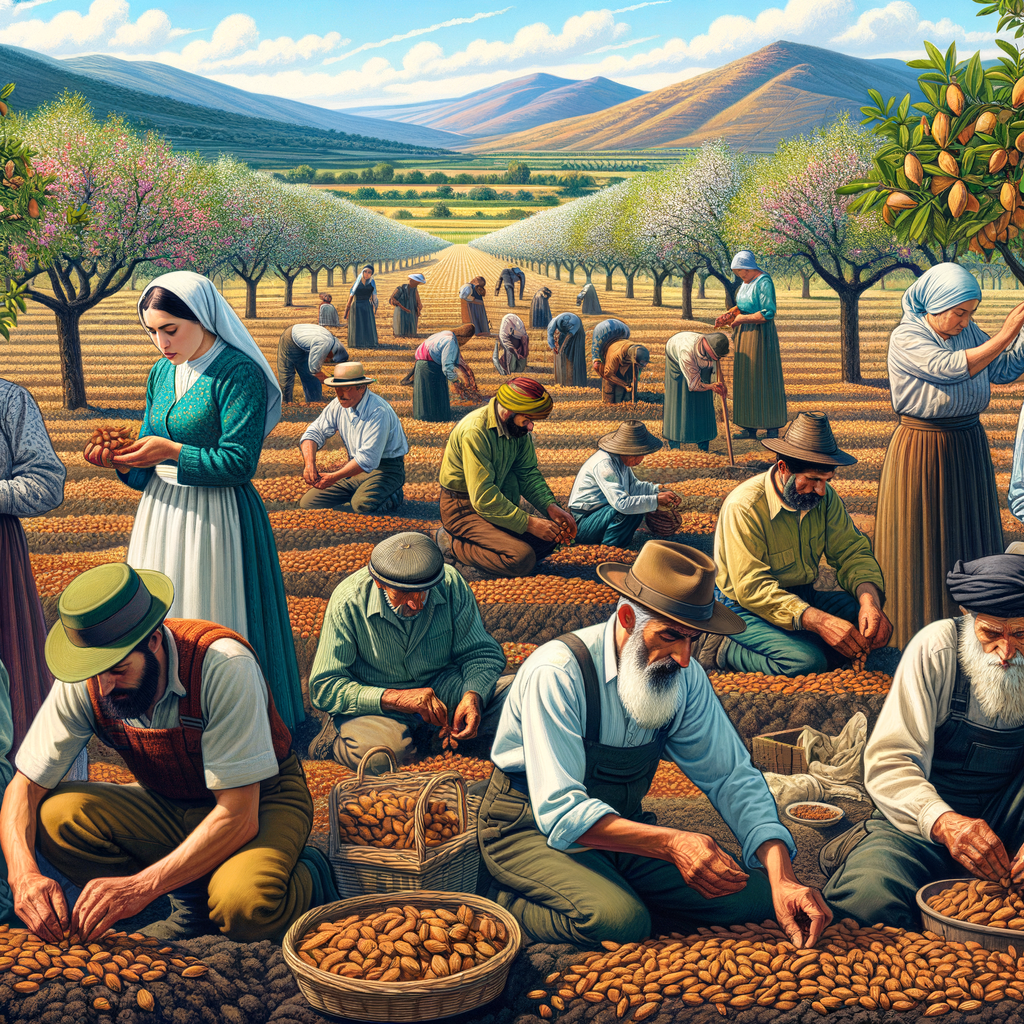
Introduction to Almond Tree Cultivation
Welcome to the fascinating world of almond tree cultivation. Almonds are not only delicious but also packed with health benefits. Growing these trees can be a rewarding experience, but it requires knowledge about different varieties, production methods, and care techniques. In this section, we will explore these topics in detail.
-
- Understanding almond tree varieties
There are numerous varieties of almond trees, each with its unique characteristics. Some of the popular ones include ‘Nonpareil’, ‘Carmel’, and ‘Mission’. ‘Nonpareil’ is known for its high yield and quality nuts, while ‘Carmel’ is favored for its resistance to diseases. ‘Mission’, on the other hand, is loved for its hardy nature and ability to withstand harsh conditions.
-
- Insights into almond production
Almond production is a complex process that involves careful planning and execution. It begins with the selection of suitable land and the right variety of trees. The trees are then planted and nurtured until they start bearing fruits, which usually takes about 3-4 years. Once the almonds are harvested, they are dried, hulled, and shelled before they reach the market. According to the Almond Board of California, the state produces about 80% of the world’s almonds.
-
- Key factors in almond tree care
Caring for almond trees involves several key factors. These include proper watering, fertilization, pruning, and pest control. Almond trees need deep, infrequent watering to encourage root growth. They also require regular fertilization to maintain healthy growth. Pruning is essential to shape the tree and promote better air circulation, which helps prevent diseases. Lastly, pest control measures should be in place to protect the trees from common pests like the navel orangeworm.
In the following sections, we will delve deeper into the specifics of almond tree planting, care, and harvest. We will also explore the cultural significance of almond trees and how they are celebrated in various cultures around the world. Stay tuned!
Almond Tree Planting
Planting an almond tree is a rewarding experience. Not only do these trees produce delicious nuts, but they also add beauty to any landscape with their stunning pink blossoms. However, before you start planting, it’s crucial to choose the right variety of almond tree. This decision is influenced by two main factors: the climate and soil conditions of your area, and the growth habits of different almond tree varieties.
Choosing the Right Variety
Choosing the right variety of almond tree is a crucial step in the planting process. Let’s delve into the two main considerations you need to keep in mind.
-
- Considerations for Climate and Soil
Almond trees thrive in Mediterranean climates, which offer mild, wet winters and hot, dry summers. They require well-drained soil and plenty of sunlight. If your area doesn’t naturally provide these conditions, you may need to make adjustments, such as adding organic matter to improve soil drainage or choosing a sunny spot for planting.
-
- Understanding Growth Habits of Different Varieties
Almond trees come in different varieties, each with its own growth habits. Some varieties, like the ‘Nonpareil’, are self-pollinating and can be planted alone. Others, like the ‘Carmel’, require another variety nearby to aid in pollination. Understanding these growth habits will help you choose the right variety for your needs and ensure a successful harvest.
In conclusion, choosing the right variety of almond tree involves understanding your local climate and soil conditions, as well as the growth habits of different almond tree varieties. By considering these factors, you can ensure that your almond tree will thrive and produce a bountiful harvest.
Planting Process
Planting an almond tree involves three crucial steps. Let’s explore each of these steps in detail.
- Site PreparationTo ensure the healthy growth of your almond tree, the site where you plan to plant it must be properly prepared. This involves clearing the area of any weeds or debris and ensuring the soil is well-drained. Almond trees prefer sandy or loamy soil, and the pH level should ideally be between 6.0 and 7.5. You can use a soil testing kit to check the pH level of your soil. If the soil is too acidic or alkaline, you can adjust it using lime or sulfur respectively.
- Planting TechniquesOnce the site is prepared, it’s time to plant your almond tree. Dig a hole that’s twice as wide and just as deep as the root ball of your tree. Place the tree in the hole, making sure the top of the root ball is level with the ground. Then, backfill the hole with soil, pressing it down firmly to remove any air pockets. Remember, the tree should be planted during the dormant season, which is usually late winter or early spring.
- Initial Care and WateringAfter planting, the tree needs special care to ensure it establishes well. Water the tree thoroughly right after planting. For the first few weeks, keep the soil consistently moist but not waterlogged. As the tree grows, it will need less frequent but deeper watering. A layer of mulch around the base of the tree can help retain moisture and suppress weeds.
By following these steps, you can ensure your almond tree gets off to a great start. Remember, patience is key when growing almond trees. It may take a few years before you see your first harvest, but the wait will be worth it when you’re enjoying your own home-grown almonds.
Almond Tree Care
Almond trees are not only a source of delicious nuts but also a beautiful addition to any landscape. However, like any other plant, they require proper care to thrive. One of the most crucial aspects of almond tree care is pruning.
Pruning Techniques
Pruning is a gardening technique that involves removing certain parts of a plant, such as branches or roots, to improve its health and productivity. Let’s delve into the importance of pruning, the best time to do it, and the different methods you can use.
-
- Importance of almond tree pruning
Pruning is essential for the health and productivity of almond trees. It helps in removing dead or diseased branches, thus preventing the spread of diseases. Pruning also encourages the growth of new branches, leading to a higher yield of almonds. Moreover, it helps in shaping the tree, making it more aesthetically pleasing.
-
- Best time for pruning
The best time to prune almond trees is late winter or early spring, just before the new growth starts. This is because the tree is in a dormant state during this time, reducing the risk of disease transmission. However, it’s important to avoid pruning during wet weather as it can lead to the spread of fungal diseases.
-
- Pruning methods
There are several methods of pruning almond trees. The most common ones include:
-
-
- Thinning: This involves removing entire branches to allow more light and air into the tree’s canopy.
- Heading back: This involves shortening branches to encourage bushier growth.
- Tip pruning: This involves removing the tips of branches to control the tree’s size and shape.
-
Remember, the method you choose depends on your tree’s age, health, and your desired outcome.
In conclusion, proper pruning is a vital part of almond tree care. It not only helps in maintaining the tree’s health and productivity but also enhances its aesthetic appeal. So, don’t overlook this important task in your almond tree care routine.
Maintenance and Pest Control
Almond trees, like any other plant, require regular care and protection from pests and diseases. Let’s delve into the specifics of these routines and methods.
- Regular Care Routines
Regular maintenance of almond trees is crucial for their health and productivity. This includes watering, fertilizing, and pruning. Almond trees need deep, infrequent watering, especially during dry periods. Fertilizing should be done in early spring to promote growth and nut production. Pruning, as discussed earlier, helps in shaping the tree and removing dead or diseased branches.
- Common Pests and Diseases
Almond trees can be affected by various pests and diseases. The most common pests include the Navel Orangeworm, Peach Twig Borer, and Almond Moth. These pests can cause significant damage to the almond crop if not controlled. Diseases such as Crown Gall, Verticillium Wilt, and Brown Rot can also affect almond trees, leading to reduced yield and even tree death.
| Pest/Disease | Damage Caused |
|---|---|
| Navel Orangeworm | Feeds on almond nuts, reducing yield |
| Peach Twig Borer | Attacks young shoots and nuts |
| Almond Moth | Feeds on stored nuts |
| Crown Gall | Causes tumor-like growths on the tree |
| Verticillium Wilt | Causes wilting and yellowing of leaves |
| Brown Rot | Causes browning and rotting of nuts |
- Pest Control Methods
Pest control in almond trees involves various methods. These include biological control, using beneficial insects to control pests, and chemical control, using pesticides. However, it’s essential to use pesticides judiciously to avoid harming beneficial insects and the environment. Another effective method is sanitation, which involves removing and destroying infected plant parts to prevent the spread of diseases.
Remember, a healthy almond tree is less likely to be affected by pests and diseases. Therefore, regular care and maintenance are key to keeping your almond trees healthy and productive.
Almond Harvest Festivals
Almond harvest festivals are a time-honored tradition that celebrate the bounty of the almond harvest. These festivals are not only a celebration of the almond harvest, but also a tribute to the hard work and dedication of the farmers who cultivate these nutritious nuts.
History of Almond Festivals
Understanding the history of almond festivals can give us a deeper appreciation for these events. Let’s delve into the origins and significance of these festivals, as well as how they have evolved over the years.
-
- Origins and Significance
The tradition of celebrating the almond harvest dates back to ancient times. Almonds were highly valued for their nutritional benefits and were considered a symbol of good luck and prosperity. The first almond festivals were simple gatherings where people would come together to celebrate the harvest, share meals, and exchange stories. These festivals were not just about the almonds; they were about community, tradition, and a shared appreciation for the land.
-
- Evolution Over the Years
Over the years, almond festivals have evolved to become grand events that attract people from all over the world. While the core elements of celebrating the harvest and community remain, these festivals now feature a variety of activities such as almond cooking competitions, almond art exhibitions, and even almond-themed parades. Despite these changes, the heart of the festival remains the same – a celebration of the almond harvest and the hardworking farmers who make it possible.
Almond harvest festivals are a testament to the enduring value and significance of almonds in our culture. They serve as a reminder of our connection to the land and the importance of community. As we continue to celebrate these festivals, we also continue to honor the rich history and tradition that they represent.
Traditional Almond Festivals
Almond festivals are a time-honored tradition in many parts of the world. They are a celebration of the almond harvest and the hard work of the farmers. Let’s delve into the key elements of these traditional festivals and take a closer look at a specific case study: The Almond Blossom Festival in Australia.
- Key Elements of Traditional FestivalsTraditional almond festivals are characterized by several key elements:
- Harvest Celebration: The festivals are usually held at the end of the almond harvest season as a way to celebrate the successful gathering of the crop.
- Community Gathering: These festivals serve as a gathering point for the community. They offer an opportunity for people to come together, share stories, and strengthen community bonds.
- Food and Drinks: Almond-based food and drinks are a staple at these festivals. From almond pastries to almond milk, these festivals offer a chance to enjoy a variety of almond-based delicacies.
- Entertainment: Traditional music, dance performances, and games are common features of these festivals, adding to the festive atmosphere.
- Almond Products: The festivals often feature stalls selling almond products, including almond oil, almond butter, and even almond skincare products.
- Case Study: Almond Blossom Festival in AustraliaThe Almond Blossom Festival in Australia is a prime example of a traditional almond festival. Held annually in Willunga, South Australia, the festival celebrates the arrival of almond blossom season and the coming harvest.
The festival is a week-long event that includes a variety of activities. There’s a fair with rides and games, a farmers market selling fresh produce and almond products, and a grand parade featuring floats decorated with almond blossoms. The festival also hosts a cooking competition where participants create dishes using almonds.
One of the highlights of the festival is the crowning of the Almond Blossom Queen. This tradition dates back to the first festival in 1969 and is a much-anticipated event each year.
The Almond Blossom Festival is not just a celebration of the almond harvest, but also a celebration of community spirit and local culture. It’s a testament to the importance of the almond industry in the region and the pride the community takes in its almond heritage.
Almond Festivals Worldwide
Almond trees are not just a source of delicious and nutritious nuts, but they also play a significant role in cultural celebrations around the world. Let’s take a look at some unique almond festivals and how different cultures celebrate the almond harvest.
- Unique Almond Festivals Around the Globe
Almond festivals are a testament to the importance of this nut in various cultures. Here are a few unique ones from around the world:
| Country | Festival | Description |
|---|---|---|
| USA | California Almond Festival | California, being the largest producer of almonds in the world, hosts an annual festival celebrating the almond harvest. The festival includes almond tastings, cooking demonstrations, and a parade. |
| Spain | Fiesta de la Almendra | In Spain, the almond harvest is celebrated with the Fiesta de la Almendra, where locals and tourists alike enjoy almond-based dishes and traditional music and dance. |
| Australia | Willunga Almond Blossom Festival | This festival in South Australia marks the beginning of the almond blossom season with a fair, fireworks, and the crowning of the Almond Blossom Queen. |
- How Different Cultures Celebrate Almond Harvest
While the specifics of the celebrations vary, the common theme across all almond festivals is the celebration of the almond harvest. Let’s explore how different cultures celebrate this event:
In the United States, particularly in California, the almond harvest is a time of joy and celebration. The California Almond Festival, held annually, includes a parade, a car show, and a variety of almond-based foods for visitors to enjoy.
In Spain, the Fiesta de la Almendra is a vibrant event filled with music, dance, and of course, almonds. The festival showcases the versatility of almonds in Spanish cuisine, with a variety of dishes featuring this nut.
Meanwhile, in Australia, the Willunga Almond Blossom Festival is a community event that marks the beginning of the almond blossom season. The festival includes a fair, fireworks, and the crowning of the Almond Blossom Queen.
These festivals not only celebrate the almond harvest but also bring communities together, showcasing the cultural significance of almond trees around the world.
Conclusion: The Cultural Significance of Almond Trees
As we conclude our exploration of almond trees, it’s important to note that these trees are not just about their delicious nuts or their role in agriculture. They hold a deep cultural significance that transcends borders and generations. Let’s delve into the cultural aspects of almond trees.
-
- Almond Trees in Art and Literature
Almond trees have been a popular subject in art and literature for centuries. The blossoming almond tree is a symbol of new beginnings and hope, often depicted in paintings and poetry. Vincent Van Gogh’s famous painting, “Almond Blossoms,” is a testament to the tree’s beauty and significance. In literature, almond trees are often used to symbolize patience and watchfulness, as the almond tree is one of the first to bloom in spring.
-
- Symbolism and Cultural Importance
Almond trees carry a wealth of symbolism in different cultures. In Greek mythology, the almond tree is associated with the goddess Demeter, symbolizing watchfulness and promise due to its early flowering. In China, almond is a symbol of enduring sadness and female beauty, while in Christianity, it represents divine approval. This wide range of symbolism shows the cultural importance of almond trees across the globe.
-
- Future Trends in Almond Tree Cultivation and Festivals
Looking ahead, we can expect to see more sustainable practices in almond tree cultivation as the world becomes more aware of the importance of environmental conservation. This includes water conservation techniques and organic farming. Additionally, almond tree festivals, which celebrate the blooming of the trees and the harvest of the nuts, are likely to become more popular as people continue to appreciate the beauty and benefits of these trees. These festivals not only celebrate the almond tree but also promote local culture and traditions.
In conclusion, almond trees are more than just a source of nutritious nuts. They are a symbol of hope, beauty, and cultural richness. As we move forward, it’s essential to recognize and appreciate the cultural significance of almond trees and continue to celebrate and protect them for future generations.







